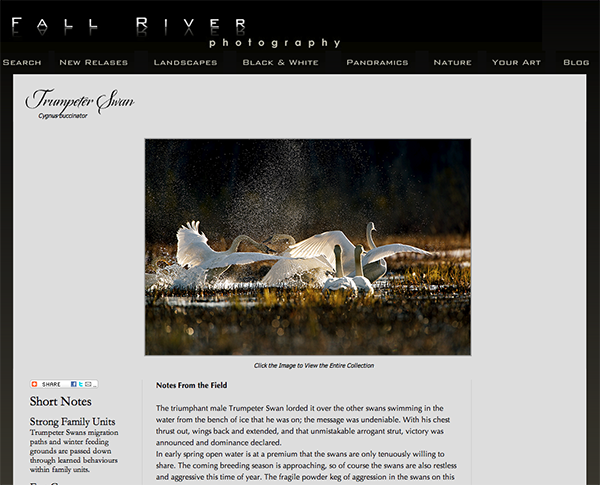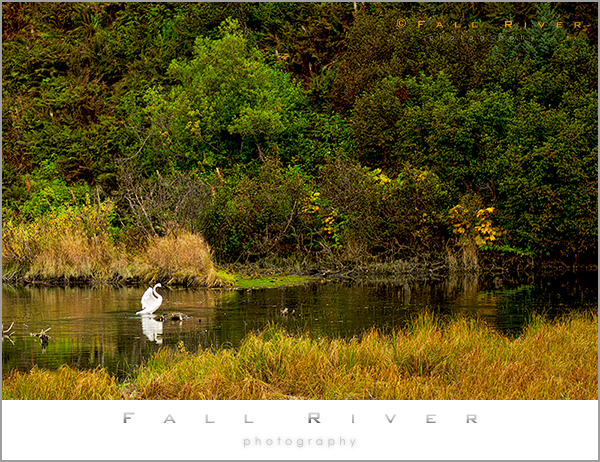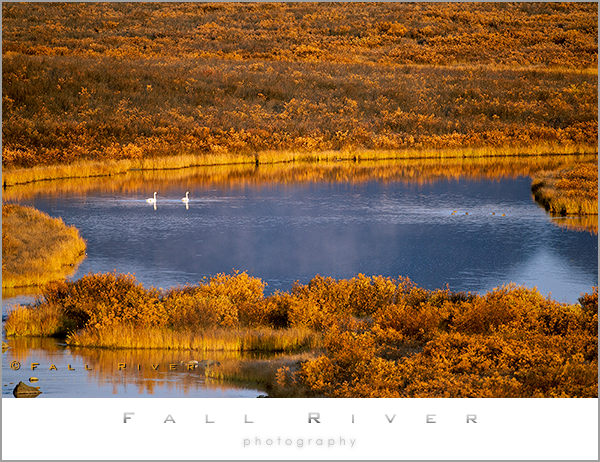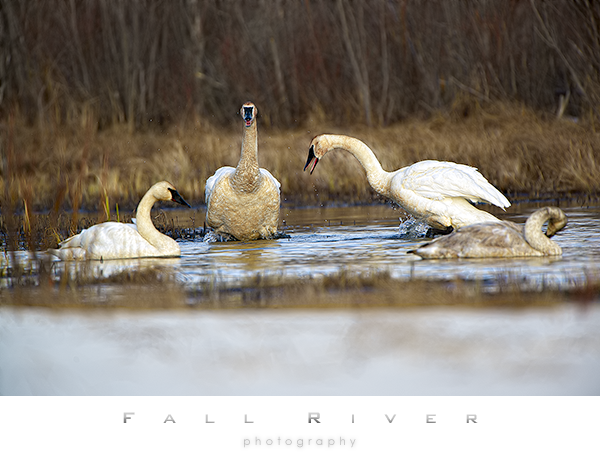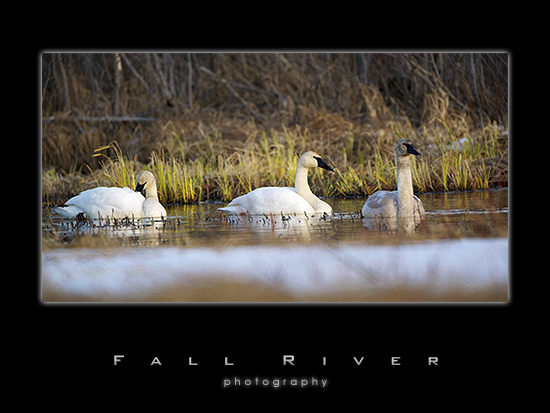On Trumpeter Swans
The following is an exert from our web page Fall River Photography on Alaska Trumpeter Swans. You can read more and enjoy our collection at this link:http://www.fallriverphotography.com/t-trumpeter-swan.aspx.
Biology
A majestic bird, the wing span of an adult Trumpeter Swan can reach in excess of 7 feet and the males, called Cobs, may weigh near 30 pounds. A Trumpeter Swan in the wild may live for 20-30 years and will usually mate for life. The breeding pair will return to the same wetlands for nesting, often using the same nest mound year after year.
The Cob and Pen (the female trumpeter swan) will build a nest mound together with the Pen pilling up the vegetation the Cob collects then creating her nest depression. After laying 5 to 9 eggs in her clutch the pen incubates the eggs for 33 days only occasionally departing the nest to feed and preen and only after covering her eggs. The nest mound is typically surrounded by water and may be as much as 6 feet high providing excellent protection from mammalian predators however, the Cob will remain on watch and vigorously defend the clutch. After the cygnets hatch they move to the water within two days to feed on vegetation and small invertebrate. Their young, called cygnets develop very quickly gaining 20% of their body weight daily and are foraging for vegetation as their parents do, with their bills, after about 4 weeks.
Shortly after the hatch a staggered molting period ensues for both adults. The Pen leads off shedding and regrowing her flight feathers on her wings and tail. The Cob follows with his molt only after the Pen has regrown her flight feathers thus ensuring there is always an adult capable of flight to defend the cygnets.
The young cygnets grow rapidly and are feathered out by the 9th or 10th week. Flight usually is not possible prior to 15 weeks of development at which time they typically weigh about 20 pounds. Flight school usually starts in September and that skill requires daily practice to make the migration flight prior to winter freeze up. The cygnets follow the adults on their first migration to the family wintering grounds learning the migratory route and winter feeding habitat. The young trumpeter swans usually remain with their brood-mates through at least the first year following their parents on the migration back to the breeding area. The young swans are then driven away by their parents but will remain together in sibling groups until reaching the age of about 2 years. Annual regrouping of trumpeter swans with their parents at the established family wintering grounds is common behavior for the offspring and strengthens the learned patterns being passed along in the lineage.
In year 3 the young trumpeter swans will select mating partners while on the wintering grounds and pair up to migrate back to the breeding areas. Unmated swans will gather in small flocks along the large lakes within their breeding grounds. Migration flights are in flocks made up of family units or comprised of several families inter mixed with non breeding swans.
Trumpeter Swans diet consists predominately of foliage, seeds and various marsh plants. Studies have shown adult trumpeter swans capable of consuming more than 20 pounds of aquatic vegetation daily. Cygnets, upon first reaching the water require a high protein diet and focus their feeding efforts on the aquatic invertebrates for the first few weeks of growth. Alaska’s high invertebrate population supports this handily. Newly introduced learned feeding patterns have provided a greater range of winter feeding habitat for the trumpeter swans. These new patterns provide for the swans to winter near agricultural fields and consume winter wheat and unharvested grains. It is notable that conflicts have arisen with farmers experiencing crop damage from roving flocks of swans but overall the swan population has benefitted from these new winter grounds.
On Trumpeter Swans
The following is an exert from our web page Fall River Photography on Alaska Trumpeter Swans. You can read more and enjoy our collection at this link:http://www.fallriverphotography.com/t-trumpeter-swan.aspx.
History
Trumpeter swans have been claiming Alaska as a breeding ground for longer than we have known they were here. Market hunting of trumpeters in the lower 48 states had decimated the species. These hunters sold Trumpeter Swans for their meat to food markets and their feathers for the millinery trade and had accomplished winnowing the population down so far as to consider Trumpeter Swans as an endangered species by the early 1900’s. By that time, the decline of the Trumpeter Swan was so precipitous that the Lacey Act of 1900 and the following Migratory Bird Act of 1929 had no ability to reverse or mitigate the decline. Another unfortunate note is that there was no legal definition of endangered species as we know it today and hence protection of the classification until 1976 so the further slide toward extinction was practically inevitable. By 1932 regardless of their status, Trumpeter Swans had been reduced to 69 wild birds. The future of the trumpeter, like so many other species that were caught up in the destruction of wildlife that the move westward produced, were on the brink of destruction. The Trumpeter Swan, a regal and majestic bird that had occupied a breeding range over most of northern America, had been brought literally to the very brink of observable extinction.
Then in 1968 an olive branch of forgiveness was extended by the forces of nature for sins of the past with the miraculous discovery of Trumpeter Swan breeding habit in Alaska. Air surveys counted 2,844 trumpeter swans in the wild that had never before been known to exist. Further efforts to better define the trumpeter swans breeding locations resulted in additional birds being found and the results of the census in 1969 allowed for the trumpeter swan to be removed from the endangered species list.
The damage to the migratory bird’s future was and actually still is severely impacted by the loss of those original migratory Trumpeter Swans. The Trumpeter Swan’s survival is based on a model of strong family bonds that pass along crucial learned patterns of behavior and habitat use. These patterns are most often passed along by older birds in the family hierarchy and it was observed that critical knowledge of wintering habitat and food sources as well as established migratory routes had been lost. The effect of this is still being seen today with biologists observing birds wintering in locations that result in very high number of winter deaths as a result of starvation.
Kung Foo Fighting
The swans were gett’n lively on the pond. The fighting ritual is very intriguing to observe. There are elaborate dances and then an attack on what seems to be a rather unsuspecting individual (I don’t think he got the memo that he was involved) , followed by a victory celebration followed by another attack as shown above. These are a few outtakes from a rather long sequence.
Trumpeter Swan
I have been spending a lot of time with these guys over on Spring Creek. There are about 12 – 18 of them at a time depending. At first the musk rat trapper was blowing them out when he came through, which unfortunately was just about the time that the sun made it over Mat Peak. Well in Alaska the light moves fast and sunrise over the peak has moved up enough that I get in and out before the trapper shows up.
Three Trumpeter Swans
It keeps thawing and the swans keep coming. I really enjoy photographing swans, they are so beautiful and graceful and here in Alaska we are fortunate to have a lot of them. Of course the Big A K is home to a lot of migrate breeding birds which makes it just too much fun.
Juvies
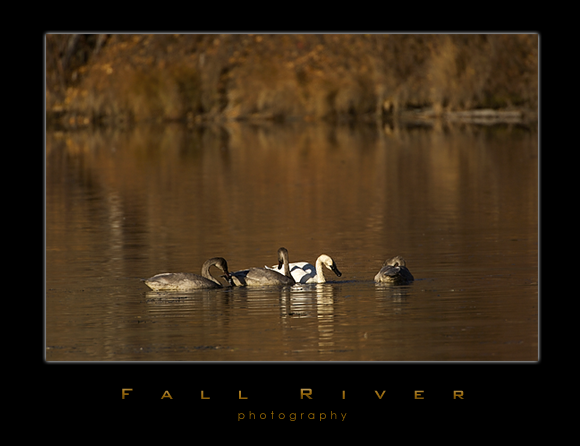
We headed over to Jim Lake yesterday morning to look for some water fowl photographic opportunities and we were rewarded handsomely. We found 4 different groups of adults and juveniles feeding, frolicking and generally doing what swans do. It was a beautiful day here in Alaska with temps (amazingly) in the 50s. We had a very healthy dose of termination dust last week and its all gone at the moment. The swans were really enjoying the weather and feeding actively. The red salmon were in and thrashing around but unfortunately due to the mortality that is involved in the end of life cycle for salmon the smell was a bit tepid. Great day to be out and about.
Alaska Swans
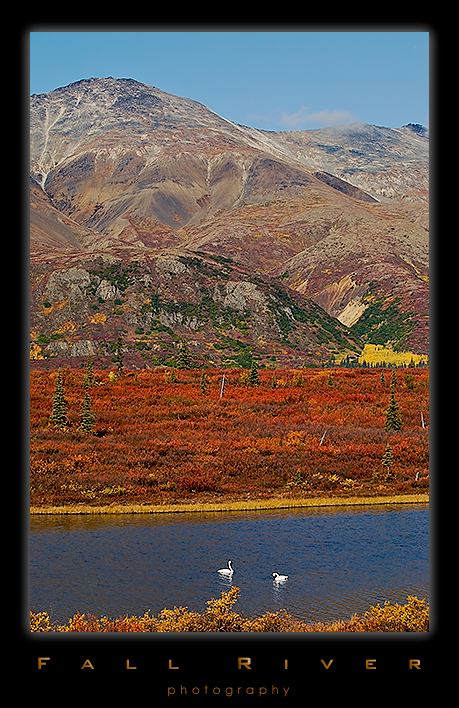
As we headed up the Parks Highway to our first location we saw these swans in a lake off the roadside. The fall colors are in full bloom and the swans were cooperative so we took advantage and had a seat on the tundra, ate some blueberries and photographed the swans. They cruised around for a little while then started feeding. If you have seen water fowl feed it’s a bottoms up routine. At that point we said goodbye and headed on our way. The swans usually stick around until the ice freezes up the water so much they loose their take off runway so they will still be here for a while.
